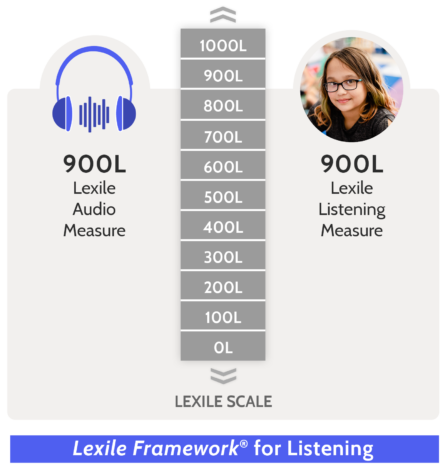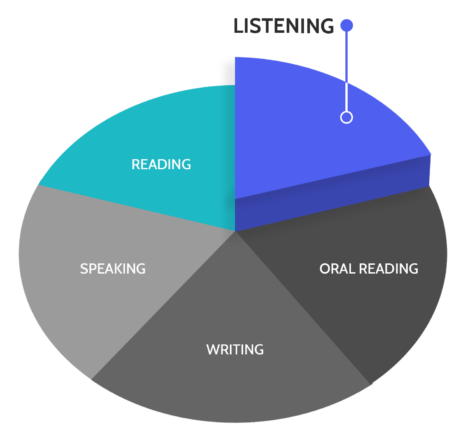About the Lexile Framework® for Listening
MetaMetrics® developed the Lexile Framework for Listening as a tool to offer a more complete picture of students’ literacy skills than reading comprehension scores alone can provide. For over 20 years, educators have relied on the Lexile Framework® for Reading to measure student growth and predict future success. Over 35 million students receive a Lexile measure for reading each year.
Just as the Lexile scale measures both students’ reading abilities and text complexity, it also measures both students’ listening abilities and audio complexity. As a developmental scale, students’ scores can be compared across grade levels and years as students grow. Students’ listening comprehension can be assessed in the early grades and monitored to ensure that growth continues.
Why Assess Listening?
Listening is an important piece of the literacy construct – both in the school years and beyond. Findings of the Graduate Management Admission Council’s study show that communication skills top the list – with listening ranked second – of skills and abilities employers look for in new hires.1
Educators can use Lexile listening measures to:
- Personalize learning by connecting students to audio materials at their ability level.
- Evaluate if their students can comprehend what they are hearing in class.
- Measure student growth using a scientifically valid, objective approach.
- Prepare students for state exams and for ELL exams that include listening.

The idea behind the listening framework is simple: If we know how well a student can listen and how hard an audio passage is to comprehend, we can predict how well that student will likely understand that audio passage.
There are two types of Lexile measures in the listening framework: the Lexile listening measure for students’ ability and the Lexile audio measure for audio materials. A student gets a Lexile listening measure from a listening test or program. For example, if a student receives a 900L on their listening test, their Lexile listening measure is 900L.
Want to Know More?
Please visit our Lexile Framework for Listening home page.
Audio Measures Differ From Text Measures for the Same Content
Have you ever listened to a radio show or podcast and not been able to catch everything that was said? Then it’s easy to see why audio measures differ from text measures even when the text is the same.
Lexile measures for audio materials are determined by the Lexile® Audio Analyzer, which analyzes the content features of what is spoken and the acoustic features of how it is spoken. Variables such as sophistication of vocabulary, amount and length of pauses, and frequency of similar sounding words factor into the Lexile audio measure. The complexity and frequency of grammatical constructions also impact the difficulty of audio passages.
Access Lexile-Measured Audio Material
 Educators can help match students with audio content at their listening level. Resources for Lexile-measured content will be quickly growing. Plans are underway for educators, parents and students to be able to find audio content matches much as Lexile® Find a Book helps students find reading matches.
Educators can help match students with audio content at their listening level. Resources for Lexile-measured content will be quickly growing. Plans are underway for educators, parents and students to be able to find audio content matches much as Lexile® Find a Book helps students find reading matches.
Educators can now access Lexile-measured podcasts at Listenwise, a subscriber-based listening comprehension platform designed to advance literacy and learning. The Listenwise library includes social studies, science, English Language Arts and current events podcasts.
MetaMetrics is actively in the process of getting more audio materials measured from content publishers. You can be a part of shaping the world’s database for Lexile-measured audio content. Just fill out the form below to indicate the audio book that you’d like to have measured. We’ll contact the publisher and hope to add it to the database soon.
Want an Audiobook Measured?
Tell us what audio books you want to have measured. Please provide contact information, so we can communicate our progress.
